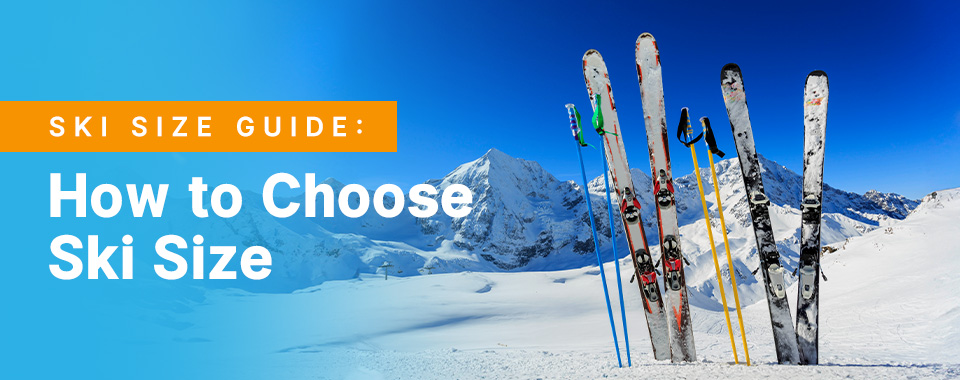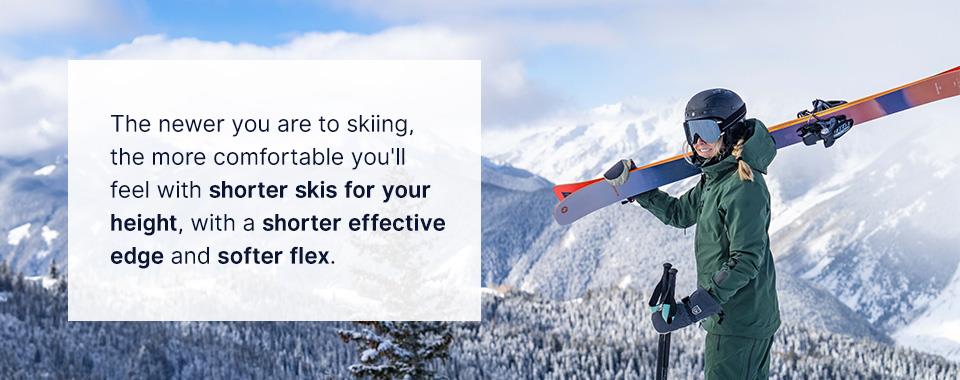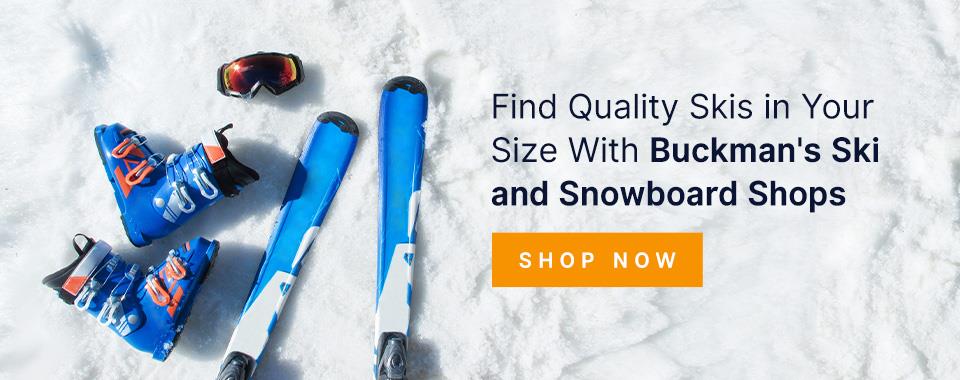 ski size guide
ski size guide
Ski Size Guide
Posted
by
Buckman's Ski & Snowboard Shops
on Tuesday, August 6, 2024
If you're new to skiing or looking for a fresh pair of skis, one of your first questions will be what size skis you need. Ultimately, the answer is whatever works for you. Sizing skis is not an exact science, but there are some solid guidelines to get you started with a great pair. Discover how to size skis for your body and your adventure.
Elements of Ski Sizing
When people discuss ski sizing, they usually refer to ski length. But skis also have different widths, profiles and flex values.
How to Choose Ski Length
Most adult skis vary in length from 120 to over 190 centimeters.
Shorter skis will generally be easier to turn and control. Longer skis tend to make wider turns and are more stable at high speeds.
Your body, experience and preferences will determine your ideal ski length.
Taller, heavier people will feel more in control on longer skis. Shorter, lighter people will enjoy better mobility with shorter skis. At the same time, novice skiers will find skis on the shorter side for their height more responsive, whereas expert skiers can handle longer skis.
How to Choose Ski Width
Ski width is measured at the ski's waist — the part below your boot, which is the ski's narrowest point. Ski width ranges from about 60-150 millimeters.
Wider skis (over 85 millimeters) are like the SUVs of skis. They are most at home on softer or mixed snow conditions, allowing you to ride over the variable snow with less effort. As skis widen, the turn radius will also grow. You will prefer a wider ski if you want to explore the entire mountain and ski off-trail.
Narrower skis (under 85 millimeters) will be most at home on groomed trails or hard-packed snow. They love to carve and be on edge. As skis get narrower, they become quicker edge to edge, allowing you to make a tighter radius turn. Like a sports car, narrow skis will give you better control in and out of your turns while still carving an edge. If you want to spend most of your ski days on groomed or hard-packed trails, you'll prefer narrow skis.
Consider what type of skiing you enjoy most. If you love exploring ungroomed trails and fresh powder, wide skis might be the better choice. If you prefer carving on well-maintained slopes, narrow skis offer better performance.
How to Choose Ski Profile
The ski profile refers to the ski's shape and construction. Profile greatly influences how skis perform on different types of snow and terrain.
Skis can have various profiles, each designed for specific skiing advantages. Here are the key elements of ski profiles you should know:
- Traditional camber: This is the traditional profile. When the ski is unweighted, the area of the ski underneath your foot will arch upward off the snow. Once the ski is weighted, it will engage the full edge length. This provides excellent edge grip and stability on groomed or hard-packed snow.
- Tip/tail rocker: A tip/tail rocker profile means that the ski’s tip — and sometimes the tail — is curved upward off the snow while incorporating the camber profile still underneath your feet. A tip and/or tail rocker helps the ski float on softer snow and initiate turns more easily. The more rocker the ski has, the less edge grip you have on firmer snow conditions.
- Full rocker: In some wider skis, there is little to no camber underneath your feet. The ski slowly arches upward toward the tip and tail from underneath your feet. This is a full rocker profile. It allows for the best flotation on soft snow, but you sacrifice edge grip on hard-packed terrain.
When sizing, adjust for the ski profile. For example, you can size down a full-camber ski for maneuverability or size up a rocker ski for stability at speed.
How to Choose Ski Flex
Flex describes how soft or stiff skis are due to different layers of materials around their core.
Manufacturers rate ski flex numerically, with a higher number indicating a stiffer ski and a lower number indicating a softer ski. Softer skis are easier to handle and more forgiving for beginners, but stiffer skis are more stable for higher speeds or harder surfaces.
Choosing ski flex involves balancing your skill level, skiing style, weight and the terrain you most frequently ski on. Beginners generally start with softer flex skis for easier control, while advanced skiers might prefer stiffer skis for better performance and stability at higher speeds.
What Size Skis Do I Need?
Now that you understand ski length, width, profile and flex, you're ready to pick the right pair for your:
- Height
- Weight
- Skill level
- Terrain
We'll look at each of these factors and explain how they affect ski sizing.
Ski Size for Height
The taller you are, the longer skis you should use.
To measure ski length, take the ski's height from tail to tip and compare it to your body. You'll probably do best with a pair of skis that reach somewhere between your chin and up to about 2 inches above the top of your head. For example, a 5-foot-4-inch skier would consider a ski height of 150-170 centimeters, whereas a 6-foot skier would opt for longer skis at 170-190 centimeters.
To determine an accurate ski length, consider your skill level. If you are a beginner skier, the tip of the ski should land between your chin and upper lip. If you are an intermediate skier, the tip should be between your upper lip and the bridge of your nose. For an advanced skier, the tip should fall between the bridge of your nose and 2 inches above your head.
Ski Size for Weight
If your weight is close to average for your height, it shouldn't affect your ideal ski size much. Choosing the right size for your height will account well for your weight. But we all have different builds, so think about yours if you're on the heavier or lighter side for your height.
If you're heavier, lean toward the longer end of the ski length range for your height. You may also prefer wider, cambered skis for broader weight distribution and a longer effective edge. Lighter skiers should lean in the opposite direction — slightly shorter, narrower skis, possibly with a rocker.
Ski Size for Experience

The newer you are to skiing, the more comfortable you'll feel with shorter skis for your height, with a shorter effective edge and softer flex. Experienced skiers chasing higher speeds will enjoy longer, stiffer skis with longer effective edges. Intermediate skiers fall somewhere in between.
The shorter the ski, the easier it is to control and initiate your turns, which helps new skiers. Longer skis give more advanced skiers greater stability at higher speeds.
Ski Size for Terrain
Once you've narrowed down your go-to sizing range for your height, weight and experience, you can adjust it to the terrain you plan to ski.
Skiing surfaces range from soft, unpacked, powdery snow to hard ice or race-condition surfaces. Packed snow sits between these extremes.
The harder the surface, the more control you'll have with longer, narrower skis with a longer effective edge and stiffer flex. If you're sticking mainly to soft snow, lean toward shorter, wider skis with a shorter effective edge and softer flex.
Ski Sizing for Children
Are you planning to take your child along for a skiing adventure? You can size your child for skis by considering the same factors you would for an adult — height, weight, experience and terrain. But start with a shorter length range between the child's chest and nose.
For example, a 4-foot-2-inch child would use skis 110-120 centimeters in length. As with adults, go toward the shorter or longer end of that range for a child who's lighter or heavier for their height.
Find Quality Skis in Your Size With Buckman's Ski and Snowboard Shops
So, you've read this ski size guide and you're ready to order your perfect pair of skis. Find the best skis to fit you online through Buckman's Ski and Snowboard Shops.
Buckman's is family-owned and operated by passionate skiers and snowboarders like you. We only carry the best brands, so you can feel confident in the quality of your skis. Every item in our inventory is there to help you get the most out of your day on the slopes.
Save money with our free shipping offer on most orders over $50 and a price match guarantee. If you're in Eastern Pennsylvania, you can order your skis for in-store pickup at a Buckman's location near you.
Browse our skis to find and order your perfect pair today. For expert advice on choosing skis from our selection, call us at 866-550-1455.

Categories:
Ski equipment
Tagged: ski